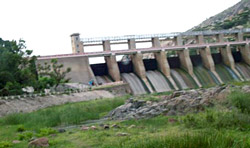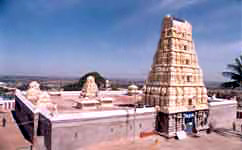The names of some of the tourist`s places are given below. There are some more monuments, temples and memorials present in the district.
Krishnagiri Dam:
 Krishnagiri dam is situated at the distance of 7 Kms from Krishnagiri. It is located between Dharmapuri and Krishnagiri. This dam helped in the irrigation of thousands of acres of land around Krishnagiri, which is in turn proved as very helpful for the district. This is a famous tourist spot too. This dam is flooded with tourists during the weekends.
Krishnagiri dam is situated at the distance of 7 Kms from Krishnagiri. It is located between Dharmapuri and Krishnagiri. This dam helped in the irrigation of thousands of acres of land around Krishnagiri, which is in turn proved as very helpful for the district. This is a famous tourist spot too. This dam is flooded with tourists during the weekends.
Thali the little England:
This place is located at about 25 Km from Hosur. It is at the border of Tamil Nadu adjoining Karnataka. This is situated in the land of valleys and cliffs. The climate is very cool and pleasant here. It experiences cold and cloudy weather resembling England. Hence this place is named in such a manner `Little England` since British Regime. The area is covered by a number of hills. The climate is cool all through the year. The taluk headquarters is Denkanikottai. In 1530 AD Palayakarar builds the fort at Denkanikottai. The fort is destroyed during war with Hyder Ali and Tippu Sultan. There is a temple for Venugopala Swami. Car festival is held during the month of May every year. Thousands of devotees visit during this festival.
Hanumanthathirtham:
This place is situated on the bank of Pennaiyar at a distance of 10 Km from Uthangarai and traditionally associated with Tirthamalai. The water at this place is considered sacred and during the Tamil month of Aadi i.e. July-August people come in a large number to visit the spot.
Kelevarapalli Reservoir Project (KPRP):
This project was constructed completely in 1995 AD. It is situated at a distance of 10 Kms from Hosur. It is only 8 Kms away from Karnataka state. This has become a picnic spot for citizens of Hosur area. Tourists from adjoining state often visit this place on holidays. They enjoy at this place and thus visited by lot of tourists every year.
Arulmigu Maragathambigai Chandra Choodeswara temple:
 This temple is located in Hosur on NH-7. Most of the pilgrims that visit the place are mainly from Karnataka state. This temple stands on a hillock. Beside this temple there is a children`s park and an observatory is setup by the tourism department. A guesthouse is also functioning under the control of Tamil Nadu tourism. This is also placed nearby.
This temple is located in Hosur on NH-7. Most of the pilgrims that visit the place are mainly from Karnataka state. This temple stands on a hillock. Beside this temple there is a children`s park and an observatory is setup by the tourism department. A guesthouse is also functioning under the control of Tamil Nadu tourism. This is also placed nearby.
Government museum:
One museum is present at this place, which is mainly known, for traditional culture, Art and Architecture, Heritage and Historical Background. This is actually a blessing in disguise. The main thought behind it is to spread the traditional and heritage, culture and art of Tamil Nadu and Krishnagiri District in particular. This museum is functioning since 1993 AD. This is situated on Gandhi Salai in Krishnagiri. Historical monuments are preserved and exhibited here at this place. It is not only a place of tourism but also a center of education. This museum collects the monuments, Classifies and preserves them to conduct research on its historical worthiness.
Monuments and memorials: There are some historical monuments and memorials present in this district. The name of these are given below:
Rajaji Memorial -Thorapalli:
The great leader Rajaji`s house was converted as a memorial. The Tamil Nadu Government does this. The house is in Thorapalli where Rajaji was born. Now this is regarded as a memorial. It is located at the distance of 10 Km from Hosur near Onnalvadi. Some of his belongings and a photo gallery depicting his various walks of life are displayed here at this place.
Rayakottah:
Rayakottah is a hill fort. This is situated at a distance of 30 Km from Hosur. This marks the border of the Palghat plateau. It was a strategic place for the British even after the Mysore wars, where their troops were stationed till 1861. The walls of the fort are more or less intact. The fort is a protected monument as of now.
History:
Description: The history of the district is very colorful as it has experiences a lot of changes during the course of time.
The Krishnagiri district has prehistoric importance. People of different corners are interested to know the facts as well. There are ample archeological evidences, which prove the presence of habitats of mankind during Paleolithic, Neolithic and Mesolithic Ages. Various rock paintings and rock carvings of Indus Valley civilization and Iron Age seen in this district. All these support the historical significance of this district. The heart of `Rishnagiri`, `Hosur` and `Uthangarai` were known as `Eyil Nadu`, `Murasu Nadu` and `Kowoor Nadu` respectively. During Chola period, Krishnagiri region was called `Nigarili Chola Mandlam` and `Vidhugadhazhagi Nallur`. According to historical sources at the time of `Nulamba` rule this district was popular as `Nulambadi`.
Hero stones were erected for those who lost their lives in movement of adventure. There was a tradition of erecting memorial stones for people who sacrifice their lives for the sake of their kings. This has been happening since `Sangam Age`. These memorial stones were called `Navagandam`. Plenty of memorial stones are available in this district. These usually speak volumes about the courage and virtues of the people. Historically part of Salem, Dharmapuri, Krishnagiri and Mysore were together named as "Thagadur Nadu" in Sangam Age.
"Adhiayaman" was the noble king offered `Karunelli` or Goose Berry to the great poetess "Avvaiyar". She adorned his court for her long life. Adhiyaman once ruled Krishnagiri and hence because of this reason it is also known as `Adhiayaman Nadu`. Pallavas, Gangas, Nulambas, Cholas, Hoysalas, Vijaya Nagar Emperors, Bijapur Sultans, Wudayars of Mysore and Nayaks of Madurai ruled this region respectively. This region of Krishnagiri served as gateway of Tamil Nadu. This is also the protective barrier for Southern region defending attacks from barriers with motives of imperialism and exploitation. Twelve Forts in this region, which are present here, were popularly known as `Bara Mahal` Forts. These forts have attacked by Mysore and Andhra rulers during the course. Krishnagiri Fort becomes the first defensive place. It always tried to maintain its status. The Vijaya Nagar Emperors built this majestic fort on Krishnagiri hill that stands as testimony still now. "Kundani" is a place in Krishnagiri District. This was once the Head Quarters of the Hoysala king `Veera Ramanathan`. The time was nearly 13th Centuty AD. `Jagadevarayan`, Hoysala kind made `Jagadevi` i.e. one of the `Bara Mahal` forts as his capital at that time.
During Mysore war I the British troops passed through Krishnagiri to attack Hyder Ali`s Forces at `Kaveripattinam`. British army was defeated here at this place by Hyder Ali`s force as well. In Mysore war II entire region of Salem and Karnataka came under Hyder Ali`s control. Hyder Ali fought bravely against the English at Krishnagiri. All knows this bravery story.
In Mysore war II after the "Treaty of Srirangapattinam" entire region of Salem and Barah Mahal were surrendered to the British. In 1792 AD, Captain Alexander Reed became the first District Collector of this region. Under the diplomacy of Robert Clive, which was extended at the time of the then Governor of Madras Presidency, Krishnagiri became the headquarters of Bara Mahal.
In 1794 AD a good deal was established at Krishnagiri. Gold, silver and copper coins were forged at this place. Rayakottai was once the strong hold of British. But it lost its importance for defense by 1880 AD. Many soldiers from Krishnagiri region took part in the world war and lost their lives. Even today a large number of youth from this Krishnagiri district are in the service of our Mother Land. Many patriots from this zone have participated in the nations freedom struggle. One noteworthy among them was the "Wise Old Man, Dr .C. Raja Gopalachari". He was from a very small village in this district, while in due course of time rose to the highest position in the nation. He was the first Governor General of independent India and also was Chief Minister at certain time.
Because of the historical importance and potential growth in education, economy and tourism. Presently Krishnagiri has created a separate district. The Government of Tamil Nadu formed Krishnagiri as 30th district. Krishnagiri district was carved out of Dharmapuri district with five taluks and ten blocks. The date was 9th day of February 2004.



















